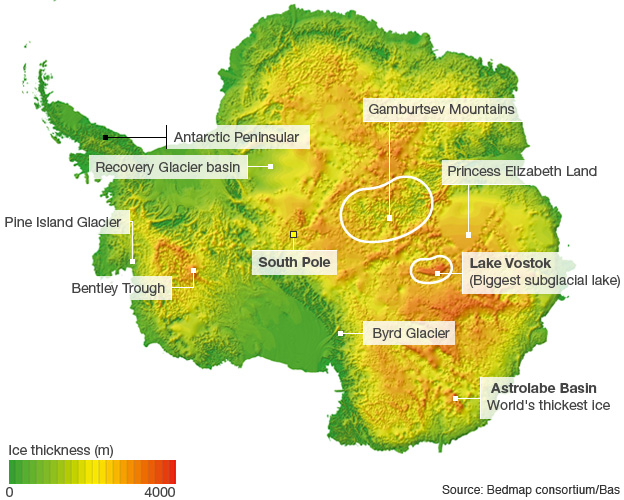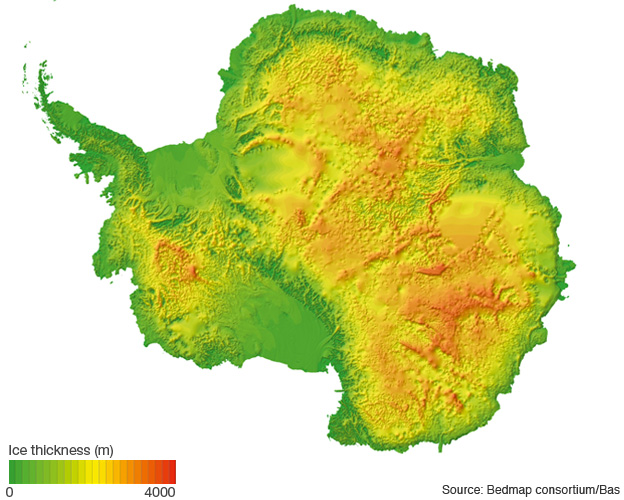'Best estimate' for impact of melting ice on sea level rise
- Published

Researchers say they now have the most accurate estimate yet for the impact of the melting of ice sheets
Researchers have published their most advanced calculation for the likely impact of melting ice on global sea levels.
The EU-funded team says the ice sheets and glaciers could add 36.8cm to the oceans by 2100.
Adding in other factors, sea levels could rise by up to 69cm, higher than previous predictions.
The researchers say there is a very small chance that the seas around Britain could rise by a metre.
The last Intergovernmental Panel on Climate Change, external (IPCC) report was highly detailed about many aspects of Earth's changing climate in the coming decades.
Advanced models
While it estimated that sea levels could rise by 18-59cm by 2100, the report was very unsure about the role played by the melting of ice sheets and mountain glaciers.
To fill the void, the EU-funded experts from 24 institutions in Europe and beyond tried to produce more accurate figures on the melting of Antarctica and Greenland and how this might swell the oceans.
Called Ice2sea, external, the group of scientists has made what it terms the "best estimate" yet of the impact of melting based on a mid-range level, external of carbon emissions that would increase global temperatures by 3.5C by the end of this century.


"For that one scenario we have an ice sheet and glaciers contribution to sea level rise of between 3.5 and 36.8cm by 2100," said Prof David Vaughan from the British Antarctic Survey, who is the co-ordinator of the Ice2sea programme.
While the range is wide, the scientists say it is a relatively robust calculation and based on several advances in modelling since the last IPCC report.
"In order to be able to model the ice sheet properly, you need to be able to resolve things down to hundreds of metres," said Prof Tony Payne from the University of Bristol.
"That's quite a task when an ice sheet is a thousand kilometres or more in size; that's a very demanding computational task. What we found is that the Pine Island Glacier, the poster child of sea level rise in the Antarctic - that will continue through to the end of the century and very little else happens."

The Pine Island Glacier developed a large crack in 2011 but scientists suggest it won't contribute significantly to sea level rise by 2100
Despite the improvements, there are still many factors that are difficult to include in models. To get around this, the leading researchers were asked to estimate the worst-case scenarios.
They concluded there was a one-in-20 chance that the melting ice would drive up sea levels by more than 84cm, essentially saying there is a 95% chance it would not go above this figure.
While ice melt is a major contributor to the height of the seas, there are other important factors especially thermal expansion caused by the warming of the waters. This contributes about a third of the observed 3mm rise in sea levels every year.
Taken together with the ice melt estimate, the scientists say the overall, maximum impact on the seas by 2100 will be a rise of 69cm - just 10cm higher than the IPCC projection in 2007, termed AR4, external.
"What we are talking about is a reduction in uncertainty - we find we haven't changed the number enormously compared to AR4," said Prof Vaughan. "We've added maybe another 10cm but the level of certainty we have around that is actually higher than it was in the AR4."
The researchers also included projections for sea level rise in Europe that includes the effects of thermal expansion, ice melt and storm surges. In these scenarios, the British Isles could face an increase of slightly over a metre by 2100 - enough to overwhelm the Thames Barrier and see London flooded once every 10 years.
But the scientists stress that there is a 95% chance that these numbers will not be reached.
"The previous IPCC identified this gap in our knowledge. We've addressed that gap and what we've found is not scary," said Prof Payne.
"We're always talking about tens of centimetres, maybe a metre tops. None of the experiments are suggesting 2, 3, 4m and that's different to the literature that existed before Ice2sea."
However, the scientists stressed that sea level rise in line with their projections could still make some islands in the Pacific uninhabitable. And if global emissions of carbon dioxide are not curtailed then the actual level of the sea by 2100 could be significantly higher than the Ice2Sea estimates.
Follow Matt on Twitter, external.
- Published14 May 2013
- Published25 March 2013
- Published10 April 2013
- Published8 March 2013